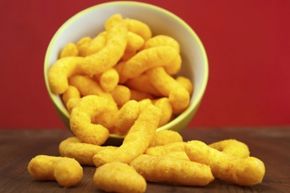Wouldn't it be great if there were a food you could eat endlessly without worrying about fat? As every delicious, perfect bite melted in your mouth, so did the calories? Get this -- with some of your favorite snacks, your brain thinks it has.
Painstakingly researched by food scientists, certain snacks and foods trick your brain into thinking those foods have no calories. First brought to light by food scientist Steven Witherly, this phenomenon is called vanishing caloric density. Here's how it works.
Advertisement
Witherly describes Cheetos as the perfect example of vanishing caloric density [source: Moss]. Besides the fact that they taste awesome, Cheetos have an interesting texture and construction that makes them melt in your mouth. When a food melts down quickly in the mouth, your brain interprets the food as having no calories – as if once the food has disappeared, so have the calories. And this is why you can keep eating Cheetos for a long time without feeling full. Other foods with the same effect include ice cream, popcorn and cotton candy.
If junk food already tastes good, we're likely going to eat it anyway. So why are food scientists so focused on vanishing caloric density? The reason is sensory specific satiety (SSS), and it's all about the psychology of eating.
Perhaps you love pizza. You love pizza so much, you think, "I could eat pizza all the time, every day." In reality, though, eventually you'd get pretty tired of pizza, and sensory specific satiety is the reason. Humans crave novelty. Even though we enjoy a certain food, at some point we'll desire something else.
When food scientists work with a company to develop snacks and products, they take facts like vanishing caloric density and sensory specific satiety into account. Snack foods like Doritos or Cheetos don't have a specific, single flavor. Every flavor melds together. This avoids sensory specific satiety, so you'll keep going back for more. And those chips melting in your mouth send the vanishing caloric density signal to your brain, keeping you dipping into the bag.
The trifecta is completed with the one-two-three punch of sugar, fat and salt. With the perfect combination of these three nutrients, our taste buds send a message to the pleasure centers of our brains, saying, "Keep eating! More, please!" And so it goes.
If you're trying to eat healthier or cut out processed foods, an understanding of the psychology and science behind processed foods is a great way to start.
Advertisement
